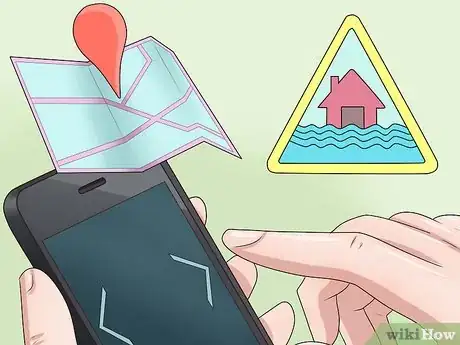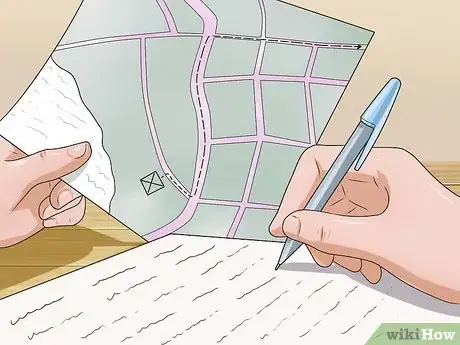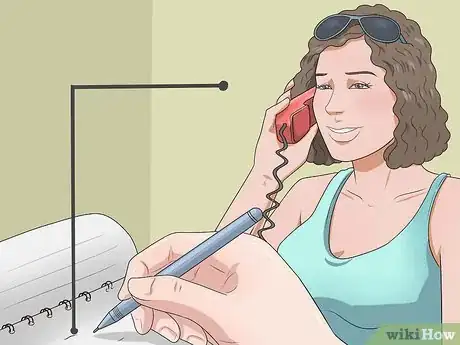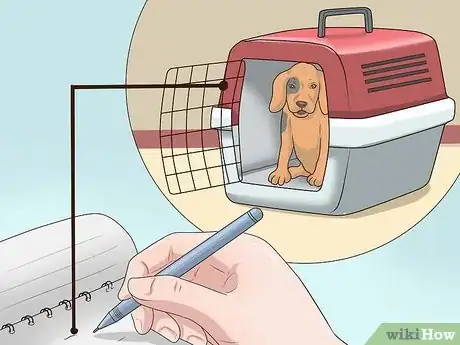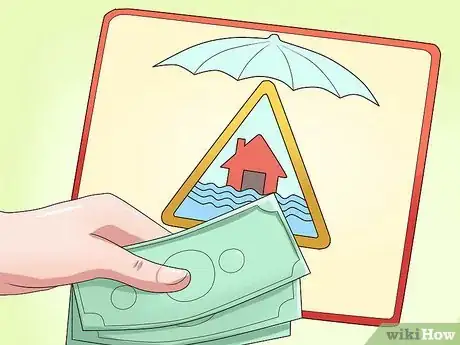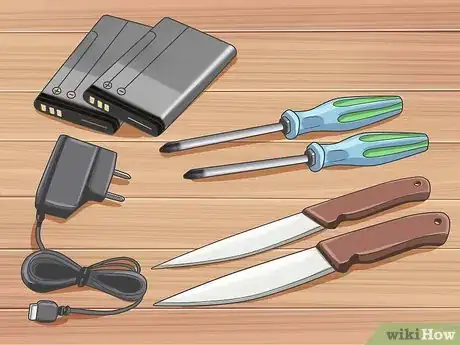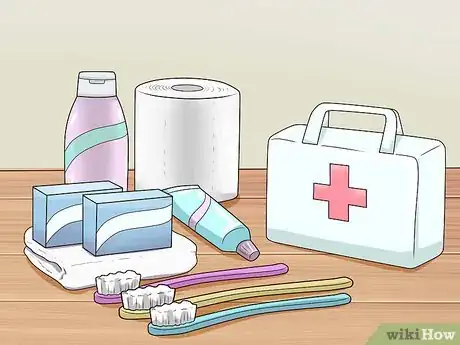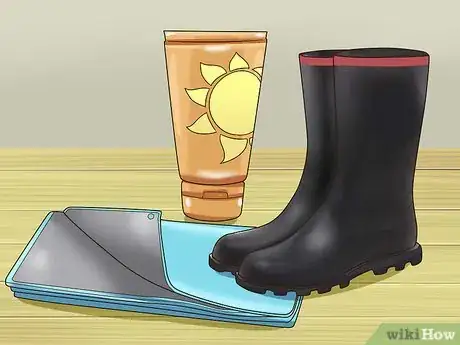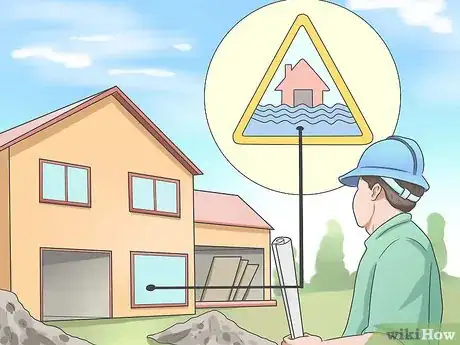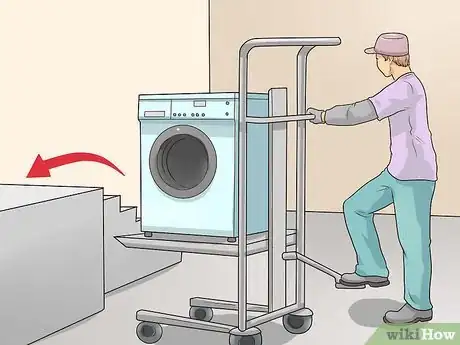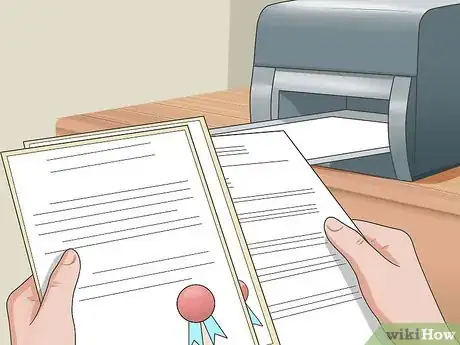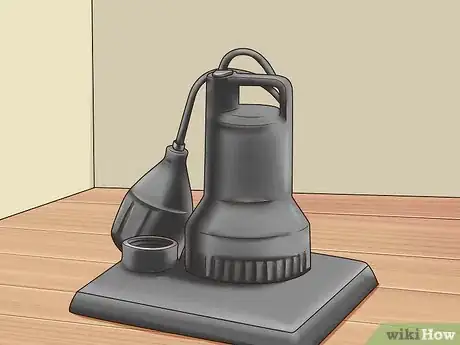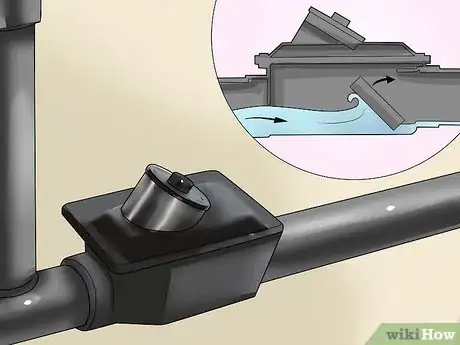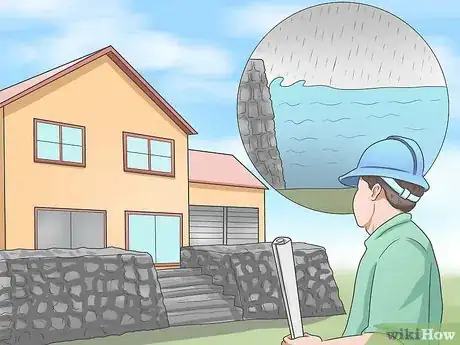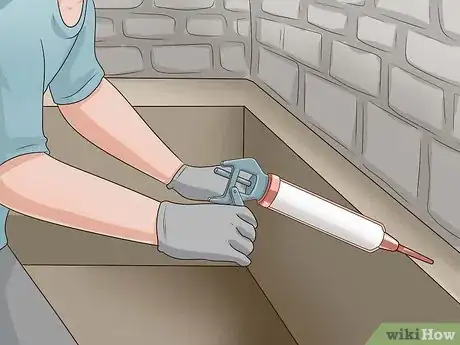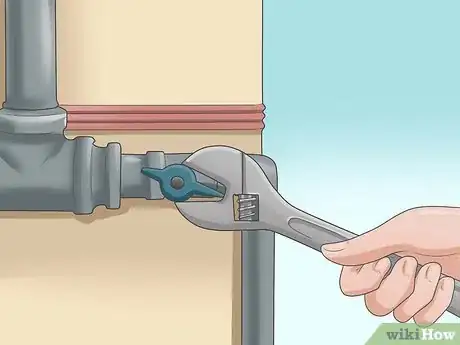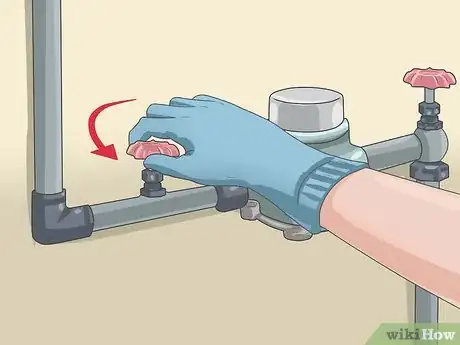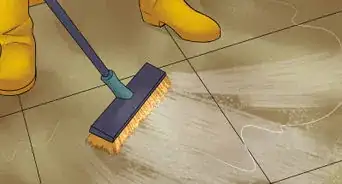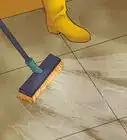This article was co-authored by Steve Linton. Steve Linton is the President of Deltec Homes, a custom home building company in Asheville, North Carolina. With nearly 20 years of experience, he oversees all home building projects for Deltec Homes. He specializes in hurricane-resistant homes, green home design, and sustainable building. Steve holds a BS in Structural Engineering from Cornell University and is a LEED Accredited Professional.
There are 11 references cited in this article, which can be found at the bottom of the page.
This article has been viewed 80,416 times.
If bad weather puts you on edge, you're not alone. Though flooding is more likely to happen in some areas than in others, it doesn't hurt to be prepared for an emergency. The article below will help you get your home and family ready if flooding happens in your area.
Steps
Creating a Plan
-
1Know your risk. If you're new to an area, you can ask the county planning department whether your home is at risk for flooding.[1] You can also check government sites for flood maps. Be sure to check back every so often; the maps are sometimes redrawn as conditions change.[2]
- The main factor determining your risk is whether you are in a floodplain or not, which you can check with flood maps.[3]
- Several other factors put you at risk for floods. For instance, if your main floor is below the base flood elevation in an area, you're at risk for flooding. You're also at risk if your near a body of water, such as a lake or a river. You're especially at risk near the ocean.
-
2Establish an evacuation route. That is, know the best ways in and out of your neighborhood and other areas of the city when it's flooded. You'll need to stick to higher ground if you need to evacuate. Also, have a planned meeting place for your family members if you get separated. Have the plan written down. Go over it together so everyone knows what to do.
- The best way to plan an evacuation route is to use flood maps, which will show where the worst flooding will be in your area.
- When planning your evacuation route, have an established place to go. For instance, you can set up a plan with a friend ahead of time to evacuate to his or her house, or go to your workplace if it is out of the flood zone. Many communities also have areas designated for emergencies where you can go.
- During bad weather, pay attention to updates from your local emergency management agency so you know whether you should evacuate or stay in place.[4]
Advertisement -
3Teach your kids how to respond to an emergency. That is, show them the emergency numbers you have displayed in your home. Show them how to dial the numbers, and go over what they need to say in an emergency. Also, have a safety contact in the neighborhood that they can go to if they have a problem.
-
4Establish an out-of-state contact. Designate one person who is not in the immediate area as the person your family checks in with. That way, at least one person will have all the information who is not in immediate danger.
-
5Include your pets. When thinking about how you will evacuate, don't forget to include your pets in your plan. Have enough carriers for all your pets so that you can evacuate them with you if needed. Carries keep pets contained so you can evacuate them without harming them.[5]
- Don't forget to include other items for your pets. They'll need containers for food and water, as well as food and their normal medications if you evacuate. Remember, not all emergency shelters will allow pets. Also, try to take something that will remind them of home, such as a toy or blanket.[6]
- If you must stay in your home, move your pets to the highest point in the house with you.[7]
-
6Buy flood insurance. If possible, buy flood insurance so that you can recover from the damage of flooding. If you live in an area with low risk, insurance shouldn't be too expensive. If you live in an area with higher risk, it will be more expensive, but it will be worth it if flooding ever destroys your home. In fact, you are required to have it in a high risk area if you have a federally insured loan.
- You can get insurance through a federal program, the National Flood Insurance Program, by filling out forms on their website.[8]
Preparing an Emergency Box for Evacuation
-
1Pack a 3-day supply of food and water. For water, that means packing enough for each person to have a gallon per day. For food, pack non-perishable foods like canned goods that you don't need to cook. Keep these supplies in a waterproof container.[9]
-
2Include the proper tools and items. You'll need a multipurpose tool that includes items like a screwdriver and knife. You also need extra phone chargers and a spare set of keys.[12]
-
3Keep hygiene supplies in your box. Keep a first aid kit in your box, along with a supply of soap, toothpaste, toothbrushes, shampoo, and other toiletry items. Antibacterial hand wipes are also good to keep on hand.[13]
-
4Include items to protect yourself from the elements. These items can include things such as sunscreen, bug spray, emergency blankets, and rain boots.[14]
-
5Keep items on hand to stay informed. That is, have a weather radio with extra batteries. You'll also need to keep friends and family informed, as well, so remember to have emergency contact information on hand.[15]
Readying Your Home and Documents in Advance
-
1Avoid building in a flood plain. As noted earlier in the article, you can ask the your county planning department about the frequency of flooding at a potential building site.[16] If you have no choice about where you build and you're located in a flooding area, you need to build an elevated, reinforced house to protect against flooding.[17]
- It's a good idea to build at least 2 ft (0.61 m) above the minimum elevation required in your area.[18]
-
2Lift major appliances and electrical outlets. Your furnace, air conditioner, electrical unit, and hot water should all be lifted above the ground to keep them from being flooded.[19] Also, electrical outlets and wiring should be a foot above any flooding that's likely. You should have a professional perform these tasks.
-
3Create copies of important documents. Make sure you have copies of all of your insurance policies, pictures of your possessions and home, and any other important documents in a safe place. You either need to keep them in a waterproof box in your home or in a safety deposit box.
-
4Put in a sump pump. A sump pump pumps out collected water, usually in basements. If you're home is prone to flooding, put one in your home, and be sure it has a battery back up in case your electricity goes out.
-
5Have back-flow valves installed in drains, toilets, and sinks. These valves prevent flood waters from coming up into the drains.[20]
-
6Create blockades for water. Have a professional evaluate your home and create barriers around your home that will prevent water from entering your house.[21]
-
7Waterproof basement walls. If you have a basement, have the walls sealed with a waterproof sealer, which will help keep water out of that area.[24]
Readying Your Home When Floods Arrive
-
1
-
2Turn off your power. If you have standing water, turn off the electricity by flipping the main breaker switch to your house's electricity. You should also turn it off if you plan to leave when there is flooding or if you see power lines on the ground.[27]
-
3Turn off the gas if you are evacuating.[28] The gas should have a shut off near the street or up against the house, depending on the type you have. You should locate it ahead of time. Generally, you turn the handle a quarter of a turn until it is perpendicular to the pipe to shut off the gas. You'll need a crescent wrench to make the turn.[29]
-
4
-
5Fill sinks and bathtubs with clean water if you are staying. Wash the areas with a bleach solution, and rinse them clean. Fill them up to have clean water available to you. Also fill up any other pitchers or containers you have with water.[32]
-
6Secure outdoor items. If you have furniture or grills, bring them inside or tie them down to secure them.[33]
-
7Move important items to higher ground. If you have enough warning, move any important items, such as electronics or valuable furniture to higher ground, such as upstairs or in the attic.[34]
Expert Q&A
-
QuestionHow do you build a flood-resistant house?
 Steve LintonSteve Linton is the President of Deltec Homes, a custom home building company in Asheville, North Carolina. With nearly 20 years of experience, he oversees all home building projects for Deltec Homes. He specializes in hurricane-resistant homes, green home design, and sustainable building. Steve holds a BS in Structural Engineering from Cornell University and is a LEED Accredited Professional.
Steve LintonSteve Linton is the President of Deltec Homes, a custom home building company in Asheville, North Carolina. With nearly 20 years of experience, he oversees all home building projects for Deltec Homes. He specializes in hurricane-resistant homes, green home design, and sustainable building. Steve holds a BS in Structural Engineering from Cornell University and is a LEED Accredited Professional.
Custom Home Builder Take time to elevate the home properly. To do this, make sure that the lowest horizontal portion of your home is above the minimum base flood elevation (which is set by the National Flood Insurance Program). To be extra safe, elevate your home at least 2 ft (61 cm) above this minimum requirement.
Take time to elevate the home properly. To do this, make sure that the lowest horizontal portion of your home is above the minimum base flood elevation (which is set by the National Flood Insurance Program). To be extra safe, elevate your home at least 2 ft (61 cm) above this minimum requirement. -
QuestionHow do you protect yourself and your property from flood hazards?
 Steve LintonSteve Linton is the President of Deltec Homes, a custom home building company in Asheville, North Carolina. With nearly 20 years of experience, he oversees all home building projects for Deltec Homes. He specializes in hurricane-resistant homes, green home design, and sustainable building. Steve holds a BS in Structural Engineering from Cornell University and is a LEED Accredited Professional.
Steve LintonSteve Linton is the President of Deltec Homes, a custom home building company in Asheville, North Carolina. With nearly 20 years of experience, he oversees all home building projects for Deltec Homes. He specializes in hurricane-resistant homes, green home design, and sustainable building. Steve holds a BS in Structural Engineering from Cornell University and is a LEED Accredited Professional.
Custom Home Builder Check if your property slopes away from your home; if so, the flood water will drain and not enter your home or foundation. You can also protect your home by clearing out your gutters and putting out sandbags.
Check if your property slopes away from your home; if so, the flood water will drain and not enter your home or foundation. You can also protect your home by clearing out your gutters and putting out sandbags. -
QuestionHow can you stay safe during a flood?
 Steve LintonSteve Linton is the President of Deltec Homes, a custom home building company in Asheville, North Carolina. With nearly 20 years of experience, he oversees all home building projects for Deltec Homes. He specializes in hurricane-resistant homes, green home design, and sustainable building. Steve holds a BS in Structural Engineering from Cornell University and is a LEED Accredited Professional.
Steve LintonSteve Linton is the President of Deltec Homes, a custom home building company in Asheville, North Carolina. With nearly 20 years of experience, he oversees all home building projects for Deltec Homes. He specializes in hurricane-resistant homes, green home design, and sustainable building. Steve holds a BS in Structural Engineering from Cornell University and is a LEED Accredited Professional.
Custom Home Builder If you're in the United States, download the Federal Emergency Management Agency (FEMA) app to your smartphone. It has tons of great information and recommendations for different emergency situations.
If you're in the United States, download the Federal Emergency Management Agency (FEMA) app to your smartphone. It has tons of great information and recommendations for different emergency situations.
References
- ↑ http://emergency.cdc.gov/disasters/floods/readiness.asp
- ↑ https://www.floodsmart.gov/why/all-about-flood-maps
- ↑ http://www.state.nj.us/emergency/flood/flood.html
- ↑ Steve Linton. Custom Home Builder. Expert Interview. 23 June 2021.
- ↑ http://www.bluecross.org.uk/2154-88393/pets-and-floods.html
- ↑ http://www.bluecross.org.uk/2154-88393/pets-and-floods.html
- ↑ http://www.bluecross.org.uk/2154-88393/pets-and-floods.html
- ↑ http://www.fema.gov/national-flood-insurance-program/standard-flood-insurance-policy-forms
- ↑ http://www.redcross.org/prepare/disaster/flood
- ↑ http://emergency.cdc.gov/disasters/floods/readiness.asp
- ↑ http://www.redcross.org/prepare/disaster/flood
- ↑ http://www.redcross.org/prepare/disaster/flood
- ↑ http://emergency.cdc.gov/disasters/floods/readiness.asp
- ↑ http://www.redcross.org/prepare/disaster/flood
- ↑ http://www.redcross.org/prepare/disaster/flood
- ↑ http://emergency.cdc.gov/disasters/floods/readiness.asp
- ↑ http://www.ready.gov/floods
- ↑ Steve Linton. Custom Home Builder. Expert Interview. 23 June 2021.
- ↑ http://www.ready.gov/floods
- ↑ http://emergency.cdc.gov/disasters/floods/readiness.asp
- ↑ http://www.ready.gov/floods
- ↑ Steve Linton. Custom Home Builder. Expert Interview. 23 June 2021.
- ↑ Steve Linton. Custom Home Builder. Expert Interview. 23 June 2021.
- ↑ http://www.ready.gov/floods
- ↑ Steve Linton. Custom Home Builder. Expert Interview. 23 June 2021.
- ↑ http://www.redcross.org/prepare/disaster/flood
- ↑ http://emergency.cdc.gov/disasters/floods/readiness.asp
- ↑ http://emergency.cdc.gov/disasters/floods/readiness.asp
- ↑ http://www.pge.com/en/safety/gaselectricsafety/turngasoff/index.page
- ↑ http://emergency.cdc.gov/disasters/floods/readiness.asp
- ↑ http://www.familyhandyman.com/plumbing/valves/how-to-locate-your-gas-shutoff-valve-and-water-shutoff-valve/view-all
- ↑ http://emergency.cdc.gov/disasters/floods/readiness.asp
- ↑ http://emergency.cdc.gov/disasters/floods/readiness.asp
- ↑ http://www.dfes.wa.gov.au/safetyinformation/flood/Pages/prepareforflooding.aspx
About This Article
To prepare for a flood, start by creating an evacuation plan that includes your pets, and establish a place on higher ground for your family to go. You’ll also want to designate one person who’s not in the immediate area that your family can check in with. Additionally, prepare an emergency box that includes a 3 day supply of food and water, important documents, medicines, and a weather radio. Before you evacuate, fill sinks and bathtubs with water so that you will have clean water when you return and turn off the power, gas, and water in your home. For more tips, including how to prepare your home in advance, read on!
